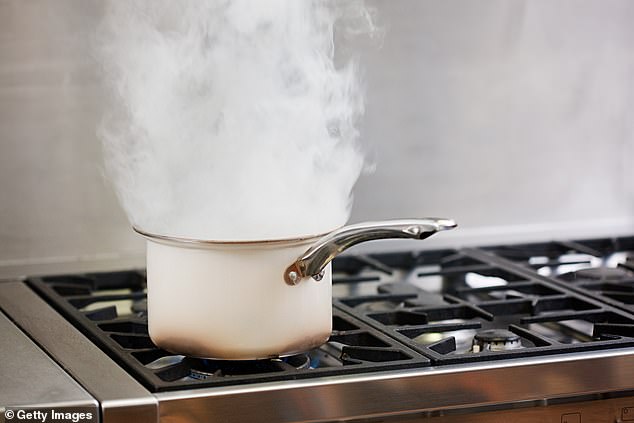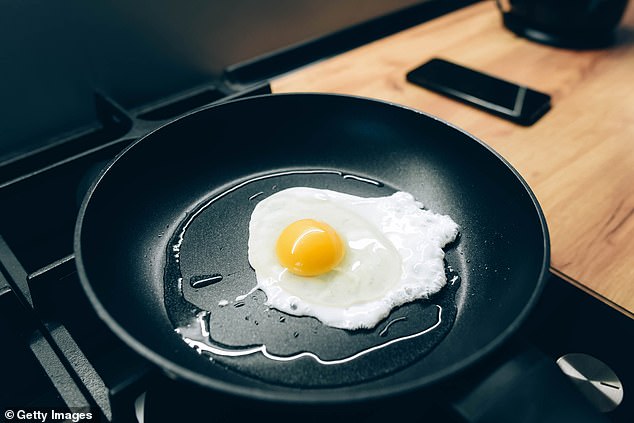Toxic fumes from burning nonstick pans sent a record number of Americans to the hospital in 2023.
Data shows that in 2023, more than 250 patients were admitted with the little-known illness called “Teflon flu,” which causes fever, body aches and chills.
Cases probably haven’t been this high since 2000, according to researchers at the U.S. Poison Control Centers, who said the condition is rarely diagnosed because it is so difficult to differentiate from other, more common illnesses.
When used correctly, these pans are harmless, but many consumers are unsure of how to properly treat nonstick pans, raising safety concerns, said Julie Weber, director of the Missouri Poison Center.
Teflon flu can cause headache, body aches, fever, chills and shaking, officials say. Sometimes symptoms appear immediately, other times they take hours.

Teflon flu occurs when a person inhales fumes from a nonstick pan made with PTFE burns.
“A lot of it comes down to a person really not taking shortcuts, following instructions and using things correctly,” Weber said. The Washington Post.
There have only been 3,600 suspected cases of polymer fume fever in the past two decades. 2023 saw the highest number of cases in decades and researchers are unsure why, highlighting the need to raise awareness about how best to use these pots and pans.
The global non-stick frying pan market was valued at $1.7 billion in 2017 from 1.3 billion dollars in 2010. This suggests that more people might buy the pans as time goes on.
Polymer fume fever occurs when nonstick cookware is heated to more than 500 degrees Fahrenheit (260 degrees Celsius), causing the chemicals in the coating to break down and be released in clouds of smoke that, when inhaled, cause coughing, body aches, fever and chills.
The non-stick coating is made of “forever chemicals” — PFAS — that burrow deep into the body where they can’t be broken down. Because it’s a rare condition, scientists don’t know exactly how it works, but it could be that the chemicals’ irritation to the lungs causes flu-like symptoms.
PFAS have also been linked to health problems such as cancer, infertility and pregnancy complications.
Sometimes, “Teflon flu” symptoms develop immediately after someone inhales these particles, but other times, symptoms take hours to develop.
This makes it difficult to report this condition.
“That’s why they tell you: don’t heat your Teflon pan to a high temperature,” Zac Hudson, an associate professor of chemistry at the University of British Columbia, told The Washington Post.
Teflon is a brand name used to designate a specific type of non-stick coating. It is the most well-known brand, but many other types of non-stick pans that do not contain it have the same problem.
They are all made from a chemical called polytetrafluoroethylene (PTFE). PTFE is one of many types of PFAS.
Coming into contact with a little of these chemicals once will not cause you any harm.
But using products with PFAS every day for years can cause the chemicals to build up in your system.
PFAS have also been found in water supplies, cleaning products and food packaging in some areas, according to the Natural Resources Defense Council.
The amount of PFAS a person is exposed to through nonstick pans is likely lower than the amount they are exposed to through other sources, said Dan Jones, a professor of biochemistry and molecular biology and associate director of the PFAS Research Center at Michigan State University.
“Most of us who work in this field would say it’s probably a very small fraction,” he told The Washington Post.

Experts recommend always heating nonstick pans with butter, oil or water to avoid overheating them and breaking down the chemicals in the coating.
Both manufacturers and scientists claim that when used correctly, these pans are safe.
But they are easy for people to misuse, so much so that six of the scientists who spoke to The Washington Post said they avoid using them altogether.
Improper use includes exposing pans to temperatures above 500 degrees F, scratching the surface with metal utensils, and using them in the oven or dishwasher.
When the pan gets too hot, the chemicals in the coating break down and are released into the air as white smoke. If the pan gets scratched, small bits of PTFE can also start to flake off and get into your food.
However, Ian Cousins, an environmental chemist and professor at Stockholm University, told The Washington Post that eating these flakes is probably not dangerous.
PTFE chemicals are large and chemically difficult for our bodies to break down, meaning they are likely to pass through the system without affecting it, Professor Cousins explained.
“I wouldn’t really worry about it. It will just go through your body,” he said. He warned that inhaling the fumes should be avoided at all costs.
In addition, the U.S. Food and Drug Administration said nonstick cookware “does not pose a safety concern to consumers.”
One of the easiest ways to avoid overheating your cookware and generating this gas is to make sure you add butter or oil to your pan before heating it, said Lisa McManus, executive editor of testing and tastings for America’s Test Kitchen. told CNET.
Ms McManus said using fat in a pan “can create an invisible build-up on the surface of the pan and form a barrier between the food and the non-stick surface when heated directly”.
If you want to avoid nonstick surfaces altogether, Ms. McManus recommends a ceramic, stainless steel or cast iron pan.


